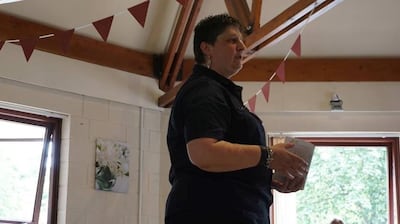Jenny Groves kept her self-harming a secret for 30 years, before finally opening up to those close to her.
“I started self-harming at 13 which is a common age for people to start and, over the years, I became addicted to it. My family and friends had no idea. I did a lot of woodwork and always had a very believable explanation for my injuries. A couple of years ago, I become so sick and tired of all the lies that I started to open up about it to my husband, kids and other people close to me.”
A determined and quite stubborn person by nature, the Leeds woman had tried to stop injuring herself on many occasions and couldn't understand how it kept defeating her.
When she opened up about her behaviour, she made the decision to stop self-harming and reach out for professional help. However, she experienced a major deterioration in her mental health and within two weeks, she was severely depressed and suffering from panic attacks.
“I hadn’t realised just how tangled up in every part of my life my self-harming had become. I had taken all my coping methods and thrown them out the window. I thought, like addiction, it was a matter of getting through a detox period, but things were getting worse and worse. I couldn’t sleep, focus or think about anything except self-harming. Reaching out for help was the right thing to do, but just stopping was not a good idea.”
Antidepressants
Having approached her GP for help, Groves was prescribed antidepressants which made her urge to self-harm even worse and also brought on strong suicidal thoughts. She was then switched to a different antidepressant which made her even worse.
She was referred to the NHS mental health service, an experience which served only to make her angry, as she was passed from pillar to post with no meaningful support offered. She finally saw a psychiatrist who took her off all medication but, unfortunately, the suicidal ideation has stayed with her.
It was as though “a switch was turned on in my brain” that she can’t turn off, she says.
Groves hit a crisis point where her suicidal thoughts were getting out of control and she went to her local A&E where she sat for seven hours before being sent home with a leaflet.
Support group
She was advised to go to a support group, but found that there was no such group in the Leeds area, where she lived. Despite the fact that she was really struggling at this stage, she decided to set up her own support group in April 2016 which she called Battle Scars.
She will be addressing the 2018 Self-harm Awareness Conference at the Aviva Stadium on Thursday, March 15th where she will talk about Battle Scars (now a registered charity) and her own experience.
“Through running the support group and hearing different experiences, some things began to click into place for me. I realised that the root of my self-harming is that I am a perfectionist and if I don’t have control over things in my life, I become extremely upset and frustrated and can’t cope emotionally.”

Every four to six weeks, Groves gets suicidal urges and becomes very low. During these periods she self-harms to calm herself down and get rid of the bad thoughts. She doesn’t feel any physical pain during the act; that creeps in later, sometimes hours later. While she is aware this is not a good long-term solution, she feels she is back in control of her emotions for a short time.
“I am extremely fortunate to have a huge support network of family and friends and I have become better at knowing my triggers. If not, I would probably be self-harming multiple times a day to keep my emotions under control. I don’t want to keep feeding the addiction and cause more damage or risk killing myself.”
Guilt and acceptance
Guilt and acceptance are two key words that those who self-harm need to focus on, says Groves.
“There is so much guilt in the cycle of self-harm, guilt that you did it, guilt that you lied about doing it. Guilt is a complete waste of time and energy. You did what you needed to do to calm down or get a bit of clarity in your head, now move on and forget about it. If you allow guilt in, it will bring you back to the beginning of the cycle and feed the urge to self-harm again. You need to try to make the cycle bigger and bigger to the point where you finally break out of it.
“You need to accept that the self-harm happened and that you needed to do it; you weren’t doing it for a laugh. Accept also that there is help and there are alternatives and open up about what’s happening.”
The most important thing to bear in mind, according to Groves, is that self-harm is a symptom and there’s no point trying to treat the symptom without finding and addressing the root of the problem.



















